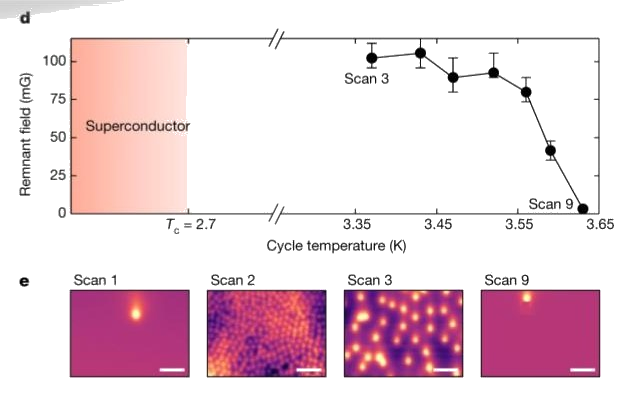Flux periodicity in a complex superconducting network
Superconducting networks often display periodic responses to external magnetic fields, reflecting their underlying structure and interactions. We investigated flux periodicity in a Kagome shaped superconducting network using scanning SQUID microscopy. By mapping the network’s response to varying magnetic fields, we identified unique periodic patterns linked to its geometry. Our findings highlight the relationship between network design and flux behavior, offering new ways to tailor superconducting devices for specific functionalities.

Magnetic memory and spontaneous vortices in a van der Waals superconductor
We report on the discovery of magnetic memory and spontaneous vortices in a van der Waals superconductor 4Hb-TaS2. Our findings reveal that the material exhibits a hidden magnetic memory effect which exists about a Kelvin above the superconducting transition (2.7 K). It is trainable, but cannot be observed directly. We see it by tracking the formation of spontaneous vortices.

Visualizing current in superconducting networks
Understanding current distribution in superconducting networks is essential for optimizing their performance in quantum technologies. We employed local magnetic imaging to visualize current flow within superconducting networks as they transition from fully superconducting to normal phases. Our observations indicate that current distribution is inherently non-uniform, influenced by factors contributing to disordered flow during the network’s collapse. These findings can assist the design and development of circuits based on superconductors and Josephson junctions, enhancing their efficiency and reliability.

Imaging quantum fluctuations near criticality
Quantum phase transitions are driven by quantum fluctuations at absolute zero temperature. Detecting these fluctuations has been challenging due to their subtle nature. In this work we use scanning SQUID to image quantum fluctuations near the superconductor-insulator quantum phase transition. Our technique captures spatial and temporal variations in the diamagnetic response, revealing the persistence of quantum fluctuations below the transition temperature. This approach provides a direct visualization of quantum fluctuations, offering new insights into quantum critical phenomena.

Direct observation of thermal fluctuations near the superconducting transition
Superconducting transitions are driven by thermal fluctuations close to the transition temperature, Tc. We used the scanning SQUID to image thermal superconducting fluctuations in Nb, and observe them in both space and time. An important outcome of these measurements is the observation that the magnetic susceptibility of a type II superconductor decreases to zero in quantized steps irrespectively to sample geometry.

Applied Physics Letters (2018)
Modulations in the superconductivity of thin films generated by the substrate
Our Scanning SQUID measurements revealed large-scale modulations of the superfluid density and the critical temperature in superconducting Nb, NbN, and underdoped YBCO films deposited on STO. We showed that these modulations are a result of the STO domains and domain walls, forming below the structural phase transition of STO. We found that the flow of normal current is also modulated over the same domain structure, suggesting a modified carrier density. Modulated superconductivity over mobile channels offers the opportunity to locally control superconducting properties and better understand the relations between superconductivity and the local structure.

Mechanical Control of Individual Superconducting Vortices

We Manipulate individual vortices in thin superconducting films via local mechanical contact without magnetic field or current. We used a scanning SQUID to image vortices and move them by applying local vertical stress with the tip of our sensor.

Vortices were attracted to the contact point, relocated, and were stable at their new location. Mechanical manipulation of vortices provides a local view of the interaction between strain and nanomagnetic objects as well as controllable, effective, and reproducible manipulation technique.
Modulated superfluid density in twinned high Tc superconductors
Several physical properties like the local strain, the bond angle, and the magnetic order may change on twin boundaries in orthorhombic crystals. These properties are known to affect superconductivity in bulk measurements. We use scanning SQUID to image the local magnetometry and susceptibility on the surface of twinned superconductors. We observe increased diamagnetic susceptibility in underdoped, but not overdoped, single crystals of the pnictide superconductor Ba(Fe1-xCox)2As2 , consistent with enhanced superfluid density on twin boundaries. Interesting information is also acquired by following the vortex behavior. Individual vortices avoid pinning on or crossing the twin boundaries, and prefer to travel parallel to them. These results help us connect the magnetic properties with the local changes in the crystal.

With: Kam Moler, John Kirtley, Ian Fisher, beena@stanford
Dynamics of single vortices on grain boundaries in YBCO thin films
Above the critical current vortices travel in a type-II superconductor allowing for dissipation. Using scanning Hall probe microscopy, we have detected the hopping of individual vortices between pinning sites along grain boundaries in YBCO thin films. The hopping frequency increased with the applied current, which drives the vortices faster. Detecting the motion of individual vortices allowed us to probe the current-voltage (I-V) characteristics of the grain boundary with voltage sensitivity below a femtovolt. We found a very sharp onset of dissipation that shows essentially no dependence on temperature or grain boundary angle. With: Kam Moler, Eli Zeldov, John Kirtley, Hans Hilgenkamp beena@stanford







